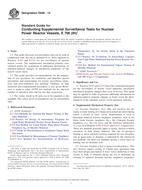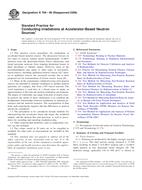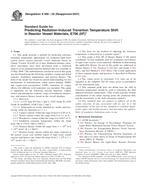We need your consent to use the individual data so that you can see information about your interests, among other things. Click "OK" to give your consent.
ASTM D7727-11e1
Standard Practice for Calculation of Dose Equivalent Xenon (DEX) for Radioactive Xenon Fission Products in Reactor Coolant (Includes all amendments And changes 11/11/2016).
Automatically translated name:
Standard Practice for Calculation of Dose Equivalent Xenon (DEX) for Radioactive Xenon Fission Products in Reactor Coolant
STANDARD published on 15.5.2011
The information about the standard:
Designation standards: ASTM D7727-11e1
Note: WITHDRAWN
Publication date standards: 15.5.2011
SKU: NS-39027
The number of pages: 3
Approximate weight : 9 g (0.02 lbs)
Country: American technical standard
Category: Technical standards ASTM
The category - similar standards:
Annotation of standard text ASTM D7727-11e1 :
Keywords:
DEX, dose correction, dose equivalent xenon, noble gases, ICS Number Code 27.120.10 (Reactor engineering)
Additional information
| Significance and Use | ||||
|
Each power reactor has a specific DEX value that is their technical requirement limit. These values may vary from about 200 to about 900 μCi/g based upon the height of their plant vent the location of the site boundary, the calculated reactor coolant activity for a condition of 1% fuel defects, and general atmospheric modeling that is ascribed to that particular plant site. Should the DEX measured activity exceed the technical requirement limit the plant enters an LCO requiring action on plant operation by the operators. The determination of DEX is performed in a similar manner to that used in determining DEI, except that the calculation of DEX is based on the acute dose to the whole body and considers the noble gases 85mKr, 85Kr, 87Kr, 88Kr, 131mXe, 133mXe, 133Xe, 135mXe, 135Xe, and 138Xe which are significant in terms of contribution to whole body dose. It is important to note that only fission gases are included in this calculation, and only the ones noted in 1. For example 83mKr is not included even though its half life is 1.86 hours. The reason for this is that this radionuclide cannot be easily determined by gamma spectrometry (low energy x-rays at 32 and 9 keV) and its dose consequence is vanishingly small compared to the other, more prevalent krypton radionuclides. Activity from 41Ar, 19F, 16N, and 11C, all of which predominantly will be in gaseous forms in the RCS, are not included in this calculation. If a specific noble-gas radionuclide is not detected, it should be assumed to be present at the minimum-detectable activity. The determination of DOSE-EQUIVALENT XE-133 shall be performed using effective dose-conversion factors for air submersion listed in Table III.1 of EPA Federal Guidance Report No. 12, or the average gamma-disintegration energies as provided in ICRP Publication 38 (′′Radionuclide Transformations'') or similar source. |
||||
| 1. Scope | ||||
|
1.1 This practice applies to the calculation of the dose equivalent to 133Xe in the reactor coolant of nuclear power reactors resulting from the radioactivity of all noble gas fission products. 1.2 The values given in parentheses are mathematical conversions to SI units, which are provided for information only and are not considered standard. 1.3 The values stated in inch-pound units are to be regarded as standard. The values given in parentheses are mathematical conversions to SI units that are provided for information only and are not considered standard. |
||||
| 2. Referenced Documents | ||||
|
Similar standards:
Historical
1.1.2014
Historical
1.8.2009
Historical
1.1.2013
Historical
1.1.2014
Historical
1.8.2009
Historical
15.7.2007
We recommend:
Technical standards updating
Do you want to make sure you use only the valid technical standards?
We can offer you a solution which will provide you a monthly overview concerning the updating of standards which you use.
Would you like to know more? Look at this page.



 ASTM E509/E509M-14..
ASTM E509/E509M-14.. ASTM E521-96(2009)e1..
ASTM E521-96(2009)e1.. ASTM E531-13
ASTM E531-13 ASTM E636-14
ASTM E636-14 ASTM E798-96(2009)..
ASTM E798-96(2009).. ASTM E900-02(2007)..
ASTM E900-02(2007)..
 Cookies
Cookies
